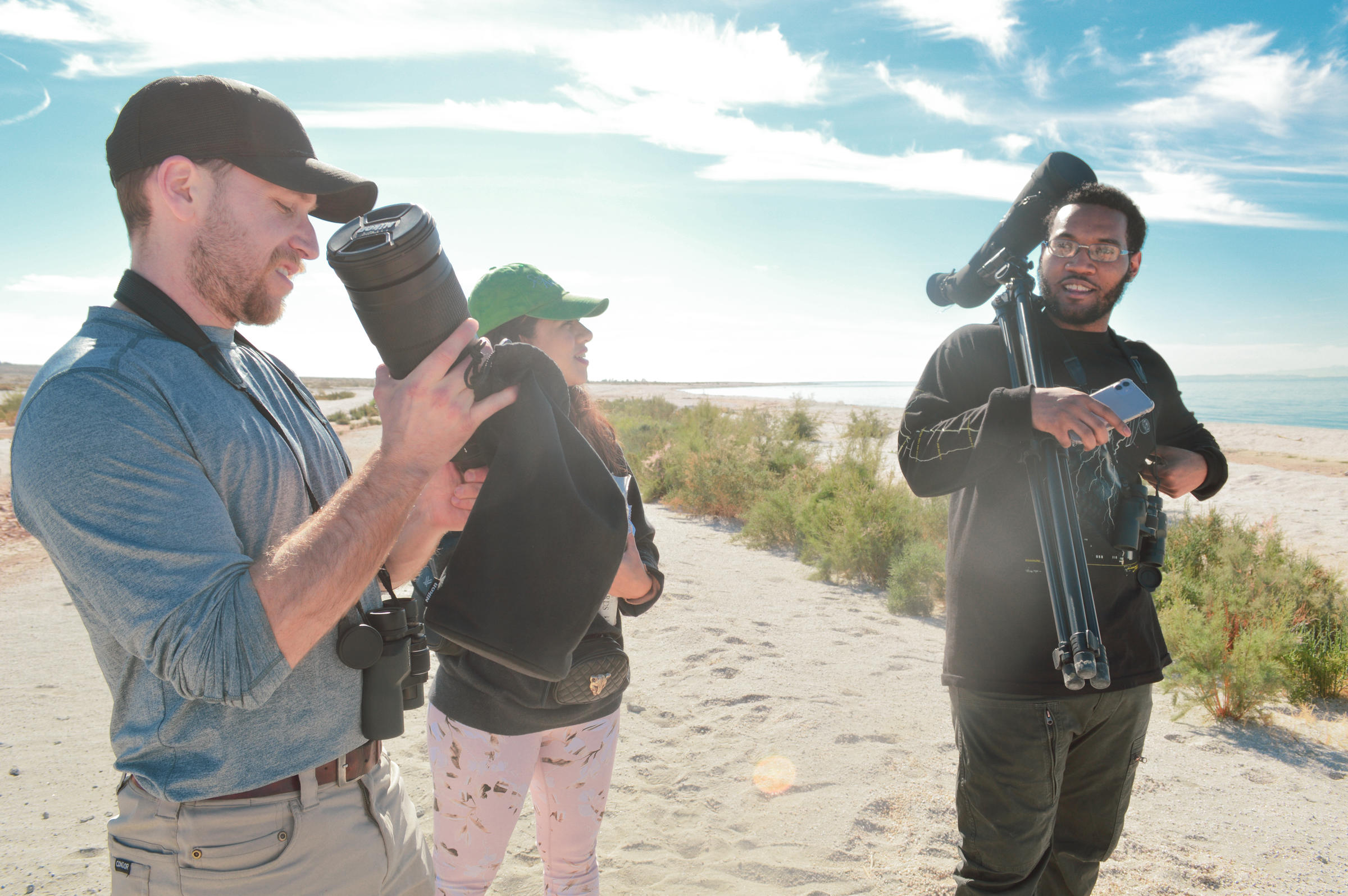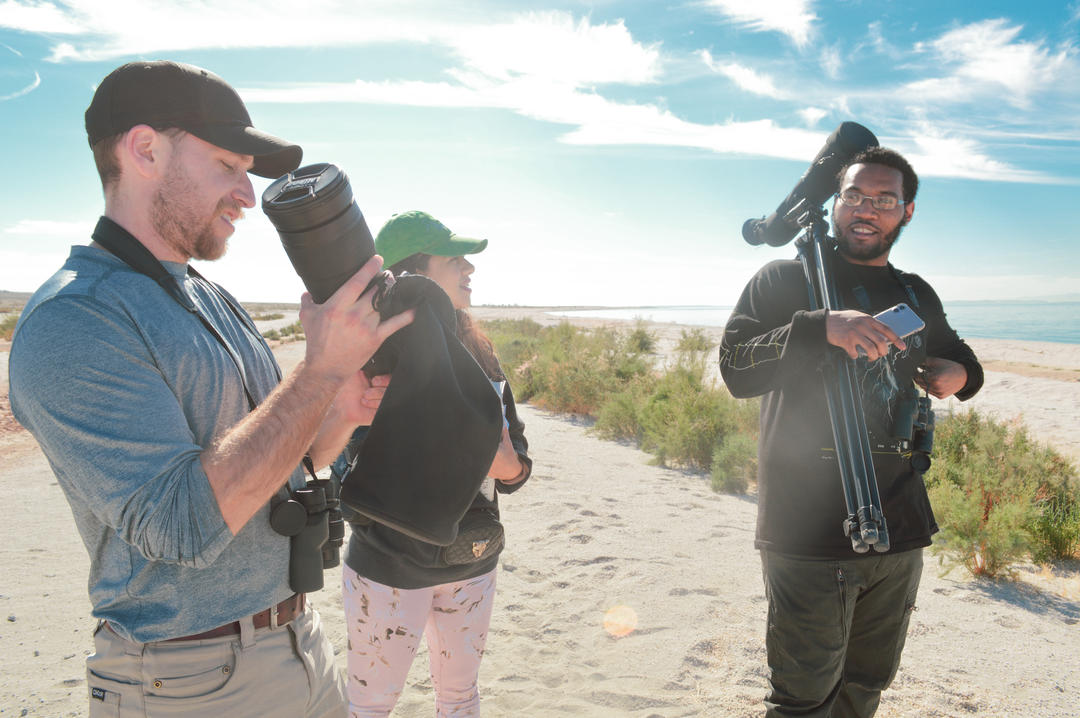Audubon California’s Salton Sea bird surveys take place once a month and have become an opportunity not only for Audubon to contribute to the ecological knowledge base that is informing Salton Sea management at a state level, but also as a way for local community members, colleagues, and partners to join us on these field days, inviting stimulating discussions about Salton Sea management.
This past month, in addition to several volunteers and partners, we were joined by our colleague Raymond Sessley with the Audubon College Campus Chapter Program. He shared with us his background as a lifelong Auduboner, his hopes for the Campus Chapter Program, as well as his impressions of the Sea with our intern, Hunter Harger.
Hunter: So, what is your role with Audubon?
Ray: I’m the Campus Chapter Associate for National Audubon. I’m from Ohio but based out of Los Angeles now. Audubon recently started this initiative where we wanted to build partnerships with the colleges and allocate our resources to the students to get them more involved with Audubon. I help start Audubon chapters on different campuses across the country.
Hunter: What would you say is the goal of starting a chapter at College of the Desert here in the Coachella Valley, for example?
Ray: I would say the main goal for the Campus Chapter Program is to address the challenge of the lack of diversity in Audubon with respect to age and people of color (POC). I feel like the College Campus Program will help in that aspect.
We did actually get some funding to work in the Coachella Valley region, and the College of Desert as a Hispanic-serving institution is one of the colleges in the area that we were excited to work with.
Hunter: We talked briefly about how you got your start with Audubon. I found your story very interesting. Would you mind sharing your experience of becoming an Auduboner as a young kid?
Ray: You know, it’s an interesting story. I feel like there would be no Ray today without Audubon, it’s so much a part of me now. I've been with the family since sixth grade. It was my first job.
The beautiful thing about Audubon is that even when you’re working it doesn't even really feel like a job. I remember moments like this as a kid when we would do bird surveys and hikes and I was like, ‘Wow I'm actually getting paid to do this, and be outside, and make a change.’ That always stuck with me.
Hunter: I agree, it’s a really important message to get across to younger people that you don’t have to sit in an office necessarily to make a difference.
Ray: Exactly. And for me specifically - being a black male in America - I notice that there are not a lot of people that look like me in this field, so just being that role model and demonstrating to younger Black kids and Latino kids of color that they do have the option to pursue a career in conservation, where they might not have seen that as an option otherwise.
I want to help advocate for those young people because it seems like they receive a message from the culture that somehow there is no space for them in conservation, which isn’t the case.
Hunter: What would you say is the biggest thing you've taken away from your experience with Audubon up till now?
Ray: I’ve learned how to go outside of my comfort zone. You know, a lot of times I will go to these meetings and I will be the only POC as well as the youngest guy there, which can be intimidating, but it has also given me the confidence to believe I could do whatever I wanted. Audubon is family to me and, like I said, I wouldn’t have become the person I am today without them.
Hunter: This is your first time to the Salton Sea. What are your what are your initial thoughts?
Ray: Initial thought - it is beautiful. And then it's kind of an eerie feeling because it’s like, ‘Wow, this large body of water is in the middle of the desert surrounded by mountains, it’s super cool.’ I could see a lot of potential for the area [as Southern California expands], I could see how it could change for the better if the Sea wasn’t as vulnerable as it is today.
Hunter: So, I'm sure Salton Sea has a bad rap in LA. I've heard people refer to it a cesspool or wasteland. What would be your response to those people?
Ray: Yeah, I've heard the same kind of comments. I’d share my experience from today with those people. There is flowing water, a lot of birds out here, so actually it’s an environment I wasn't expecting to see. It’s actually quite beautiful. However, I know there are problems here as well.
It suffers from lowering water levels and the lakebed is becoming exposed. After talking with some locals, I realized that the communities around the Salton Sea are some of the poorest in the country with a high population of Latinos. It’s hard to ignore them factors when it comes to the condition of the Salton Sea.
The Salton Sea is environmental injustice and should receive more attention and resources. The Audubon Campus Chapter Program plans to create a chapter at the College of the Desert to help engage the younger demographic. I think this program can help play a part in addressing these issues of environmental injustice and integrate ideas of diversity, equity, and inclusion into land and water management going forward.
See more pictures on our Instagram @audubon.saltonsea
Audubon California will be performing its March bird survey at the Salton Sea on Saturday, March 28. If you are in the area and would like to join, please email saltonsea@audubon.org







